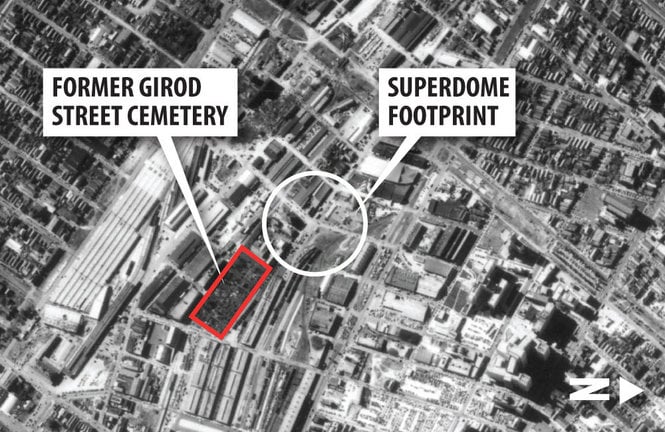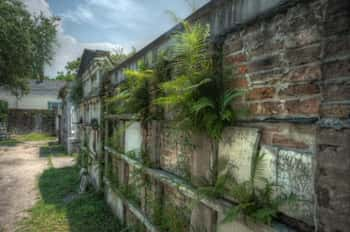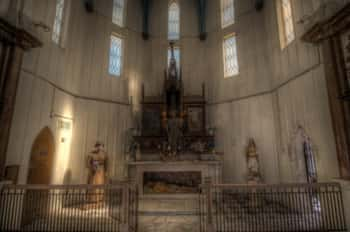
If New Orleans is known for one thing (aside from Bourbon Street and Mardi Gras, of course), it's for our cemeteries, and only a city like New Orleans would proudly boast the moniker "Cities of the Dead." Thousands of tourists and locals alike go on cemetery tours in New Orleans every year, where the main attraction is St. Louis Cemetery, No. 1, the final resting place of the voodoo queen herself, Marie Laveau. But, that's just the Space Mountain of this Disney World of cemeteries. New Orleans is home to many underground cemeteries that are defunct, forgotten or lost altogether, and you never know when you may hear the wailing moans, or spot apparitions of those who are destined to haunt their grounds for eternity.
Those who dare to explore any haunted cemeteries, would be best advised to heed Marie Laveau's warnings.
"Although one is pure of thoughts and in heart, searches for the gates of the truly dead. You never know when the November winds blow, if the cursed gates are searching for you too."
"If you enter the gates backwards you might have a small chance, to flee with your life all intact. But if your motives are untrue then the living death calls your name, then there is nothing you can do."
– Marie Laveau
Here are New Orleans' Top Underground/Lost Haunted Cemeteries
The most infamously known grounds of departed souls is the former home of the integrated Girod Street Cemetery, once a sight to see, with it's multi-tier tombs. Unfortunately, it eventually fell prey to disrepair and was disestablished in the year of 1957, and the ghastly decision was made, to do the unthinkable, to move the skeletal remains to other cemeteries. Every skull, tibia, and femur were thought to have been gathered, segregated and re-homed to the Hope Mausoleum of New Orleans and the Providence Memorial Park of nearby Metairie. But, when ground was broken in 1971 for the site of the upcoming Superdome, it wasn't long before bones were unearthed, and there were plenty more that followed.

"I never got into the curse," said New Orleans Saints' legendary quarterback, Archie Manning. The man who was the only hope for Saints fans for years, years of paper bag wearing Aints' games, believed to be the work of the curse that was brought on by the disturbed souls of Girod Street Cemetery. "Maybe I was always too busy or somebody was hitting me in the mouth or something. . . . Maybe there is something to it," Archie reflected on the curse.
Despite the curse "The Curse of the Dome," that plagued the Saints for decades, the Superdome wasn't actually built upon the site of Girod Street Cemetery—in reality, it was a parking garage next to the Dome that was the designee of this most unfavorable distinction. But, that hardly seems to sway believers of the curse, those who believe the force was reawakened, or may have never actually been resolved, judging by the incredible misfortune the team has experienced since its Super Bowl XLIV victory, with issues in and out of the Dome. Such as, Bountygate, Sean Payton's year long suspension, Reggie Bush's forfeiting of his Heisman Trophy, and a host of other mysterious—and unfortunate—incidences.
The curse does not seem to be limited to The Saints alone. The world experienced the power of the curse from the comfort of their own living rooms, when during Beyoncé's performance at Super Bowl XLVII Halftime show a blackout inexplicably occurred.
"When I'm here alone, I often think about Katrina," said, Doug Thornton, the Executive Vice President of Stadiums and Arenas. "I try to forget about the [Super Bowl blackout]. With Katrina, I'm amazed we didn't lose more lives, given the circumstances—no running water, very little food, running on generated power for seven days." He went on to add, "The power outage was a totally different thing. It was so sudden. I would almost give you the analogy of an earthquake. There are parts, when I look back on it, they're hard to explain."
Perhaps, the only explanation for the blackout is the continuous of the curse. Just ask a New Orleanian, and they'll tell you, the lost spirits of the Girod Street Cemetery that haunt the Superdome are responsible for all the strange happenings that occur, and that building a stadium on, or near, an old cemetery had the team doomed from the start.
The "Cities of the Dead," made news again in 2011, when a man by the name of Vincent Marcello had just begun the process of having a pool installed in the backyard of his French Quarter home, when the digging unearthed 15 bodies. Now, if you're a local and you hear the name "Marcello" mentioned in the same sentence as 15 unearthed bodies, you probably wouldn't be surprised. But, this wasn't the work of late notorious crime boss Carlos Marcello, nope, this was a discovery of the lost St. Peter's Street Cemetery.
"It doesn't bother me at all," Vincent Marcello responded, when asked by a reporter if he was squeamish about the event. "But I find a few people could get squeamish about it. But you go to church in St. Louis Cathedral and you walk over the (graves of) archbishops and the priests, so it's no big deal." On another occasion, Marcello added, "It's all part of the New Orleans culture. I think they [neighboring residents] might even like it."

The area of where the coffins were found was once the Smokey Row section, the predecessor to Storyville. The prostitutes were known to kidnap men, snatch them from the street, haul them inside—then take their belongings and even murder them, depositing their bodies in the yards of their brothels. It's one of the reasons the backend of the French Quarter is considered to be so haunted, the forgotten souls of St. Peter's Street Cemetery just might be the reason for all of the paranormal phenomena.
New Orleans is also home to numerous Potter's Fields, cemeteries designed strictly for the city's poor. One of the better known Potter's Fields is Holt Cemetery, named after Dr. Joseph Holt. The cemetery is located next to Delgado Community College upriver from the French Quarter area. Students have been known to sometimes park around the cemetery, rolling the dice on whether or not a cop will come along and give them a ticket.
In contrast to most of the cemeteries in New Orleans, Holt Cemetery is unique, and not just because it's one of New Orleans' few below-ground cemeteries. Instead its noted for its style, with hand painted tombstones, wooden crosses, stuffed animals, dolls and chairs clustered amidst the grave sites. At night, ghostly images have been spotted by those who are brave enough to head out to the cemetery, and those who have stayed out past midnight have even heard singing. Could it be that the spirits of musicians Charles "Buddy" Bolden, Jewell "Babe" Stovall and Jessie Hill are putting on the best festival New Orleans has to offer? Additionally, reports of orbs and light anomalies are commonly spotted, along with the feeling that someone is reaching out to those who visit, some have even felt a tug on their shirts, but upon turning around, expecting to see someone behind them, the eerie realization hits them, they are alone.
Holt Cemetery's predecessor Locust Grove Cemetery was established by New Orleans in the year, 1859, for the city's indigent. Locust Grove Cemetery No. 2, opened in 1877. Both cemeteries were shut down in 1879, and were later demolished. In 1898, the Thomy Lafon School and a playground were built in their place. Creepy? Yeah! Building a playground on top of a graveyard, is the makings of a bad horror movie.
The school had to be rebuilt in 1905, after it was burnt down by white terrorists. Almost a half-century later, a new school building was constructed on the site in 1954, but suffered another tragedy as it was badly damaged by Hurricane Katrina. In 2011, the historic school was demolished itself, even though it was listed in the 2008 "New Orleans' Nine Most Endangered Sites" by the Louisiana Landmarks Society. Now, the Housing Authority of New Orleans (HANO) is planning to turn the vacant lot into a park, and with further development, comes further disruptiveness for the restless bones that lay beneath the surface, forever haunting the turbulent grounds.
In 1848 Charity Hospital purchased another Potter's Field, another site for the city's unclaimed, including those who died from the yellow fever and influenza epidemics. The incredible number of dead made it necessary that a place like Charity's Hospital needed to open up a new cemetery. Like Holt Cemetery, this was one of the few graveyards in which bodies were buried underground, leaving those restless souls to linger at this potter's field. Despite being one of the city's largest cemeteries, Charity Hospital Cemetery is the least known of its contemporaries, (such as, St. Louis Cemetery, No. 1.), it seems that even in death the poor are forgotten.
Although its existence is less known today, that hasn't stopped people from visiting its grounds. Countless people have reported a deep feeling of sadness while walking through the cemetery, perhaps the same emotion that those unfortunate diseased victims experienced all those years ago. Other visitors have even seen ghostly shapes dressed in hospital gowns, strolling through the grounds, sometimes even running into the street and startling pedestrians, causing motorists to slam on their brakes. And, at night the graveyard sounds more like the inside of a hospital: wailing moans and rickety gurneys all around. The site is now a memorial for the victims of Hurricane Katrina, taking up nearly half of the grounds with only the back of the cemetery remaining untouched.
From the defunct and forgotten to the lost, Bayou Saint John Cemetery—also known by various other names including Bayou Saint Jean Cemetery, the City Cemetery, the First Municipality Cemetery, the New Cemetery, and yes, even Potter's field—is a cemetery whose location remains uncertain even to historians. Some suspect the "lost" cemetery's location is close to the intersection of Bayou St. John and the Carondelet Canal (The Old Basin Canal) opposed to the previously believed location, near the area around Esplanade Avenue.
The need for this "New Cemetery" was great after the yellow fever epidemic in 1832, followed by another in 1833, where in one month alone a reported thousand people died. St. Louis Cemetery No. 2 quickly ran out of space for new souls, which led to the City Council authorizing an ordinance in 1835 that required the people who died in New Orleans, or in nearby areas, to be buried on the land next to Bayou St. John that was purchased from Evariste Blanc. With the distance being well over a mile, the realization of the need for transportation became abundantly clear. John Arrowsmith, who also owned land in the area, decided to capitalize off the dead, with his proposition of building a railroad to transport the corpses.

Burials in the cemetery began in the year of 1835, with the register showing that free blacks, slaves and whites were interred into the Bayou St. John Cemetery despite the common practice of the time to separate each group by race. In 1844, the cemetery had been filled, and by 1880 it had disappeared from existence, along with Arrowsmith's railroad. To this very day neither have yet to be rediscovered. While most cemeteries have ghosts, the Bayou Saint John Cemetery is a rarity, as it is a ghost unto itself.
The stories of Marie Laveau's rituals held along the banks of Bayou St. John are the very thing that helped to create her legend. The voodoo queen would visit the northern section of Carondelet Canal, a secluded area of the bayou; there, she and the faithful would sing, make offerings, and dance under the moonlight. Although it's tough to say, considering that Bayou St. John Cemetery is a bit of a mystery, it's believed that Marie Laveau might have practiced her faith in the same area in which John Arrowsmith had built his railroad for the dead.
Voodoo aligns itself with The Catholic calendar for celebrations, the calendar marks June 24 as the Feast of St. John. Voodoo priestesses and priests alike hold ceremonies on the Eve, before the St. John's Feast. At Bayou St. John's Magnolia Bridge (just in front of Cabrini High School), an annual event is held for St. John's Eve head washing ceremony to which all are welcomed to join, free of charge. A headwashing (lave tèt) is a form of Vodou Baptism. Those who participate are asked to wear white with a white headscarf. People should also bring an offering for Marie Laveau such as, dishes, hair ribbons, blue and white candles, flowers, gris-gris bags, rosaries and obviously saint's medals.
"It celebrates the birthday of St. John the baptist and is considered at the time of summer solstice, where the sun is perceived as stopping in the heavens and turning around, symbolizing renewal and rebirth" said voodoo priestess Sallie Ann Glassman (who was the initiator for Ghost City Tours' own guide and voodoo priest, Michael Bill). She continues on to say, "We honor Marie Laveau and her spirit 150 years after her death and she is still very active in New Orleans and people still go to her for help and healing and empowerment." "I think it's very important for people to experience a voodoo ceremony first hand and to realize that it's not the terrifying evil practice that it is portrayed on TV and in books and it's actually a beautiful thing that we in New Orleans can be very proud of."
But, those with impure intentions, should remember Marie Laveau's words "If your motives are untrue then the living death calls your name, then there is nothing you can do."

New Orleans' most haunted Cemetery

The Garden District's haunted Cemetery

Where a ghost dog is seen